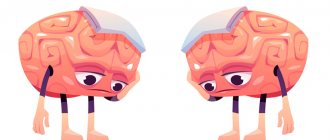There are several forms of disorientation: this is psychological, which usually manifests itself as a syndrome of derealization and depersonalization, and neurological, which occurs with more obvious symptoms. The latter occurs against the background of organic brain damage. Disorientation requires mandatory comprehensive treatment, but the medical doctor determines the treatment regimen only based on the results of a diagnostic examination.
General information about the disease
The most common type of disease is senile (senile) dementia. Develops in people of the older age group (after 60 years). It is an aggravated form of natural degradation of brain neurons, most often accompanied by other diseases, including Alzheimer's disease, AIDS, encephalitis, and infectious meningitis.
Dementia in the elderly is incurable. The therapy offered today is aimed only at alleviating the condition of patients, as well as slowing down the process of degradation of cognitive functions. That is, it is necessary to understand that the patient’s condition will gradually worsen to the point that he will require constant round-the-clock care.
Psychogenic amnesia
Conditions that lead to the loss of memory of a certain part of data about one’s personality are called psychogenic. These types of amnesia include:
- Katathimnaya. The patient forgets only those data that are in some way related to psycho-emotional experiences.
- Hysterical. Often observed in hysterical psychopathic syndrome. In this case, the person cannot remember only the traumatic moment.
- Post-hypnotic. The patient is unable to reproduce what happened to him in a trance state. This is usually part of the suggestion.
- Dissociative. Refers to the body's protective reactions that do not allow the destruction of mental functions. Memory for events that cause severe stress is erased. It differs from other types of psychogenic amnesia in that the loss itself is a treatment and relief from further problems.
- Dissociative fugue. Also refers to defense mechanisms, but at the same time a person escapes from a difficult situation by moving to another city and forgetting about his past life and his personality. At the same time, he retains his basic skills completely. After some time, events are restored, usually this happens suddenly and immediately.
Causes of senile dementia
In every person, neuronal activity deteriorates with age. This is due to the natural biological processes of aging. Hormonal levels change significantly, the sensitivity of neural connections decreases, and the brain loses the ability to normally absorb the entire spectrum of nutrients it needs. Senile dementia is a similar process, but occurs in a more active and rapid form.
The main provoking factors of the disease:
- Other diseases of the brain and nervous system (infectious and non-infectious). Act as a catalyst in which neurons lose the ability to fully absorb micronutrients.
- Vitamin deficiency. In particular, B-group, folic acid.
- Kidney, liver, heart failure. Accompanied by disruption of the normal functioning of the vascular system, a smaller volume of oxygen and nutrients is transported to the brain, which causes destructive processes in the cortex.
- Hormonal imbalance.
- Genetic factor. Often this disease is diagnosed to those who already have (had) relatives with the same diagnosis
In about 60% of cases, people with dementia also have Alzheimer's disease.
Organic amnestic syndrome
The causes of organic amnestic syndrome can be various lesions of brain tissue: cerebral arteries, white matter, nerves or cerebral cortex. It also leads to the appearance of hematomas and hemorrhages in the central nervous system. The cause of the deviation is sometimes carbon monoxide poisoning with massive brain damage.
When the functions of the temporal regions are disturbed, as happens with epilepsy, they also lead to the fact that a person develops amnestic syndrome. Its causes are:
- malignant tumors, especially when the ventricular walls are damaged;
- Alzheimer's disease and other types of dementia (Lewy, Creutzfelt-Jakob, atherosclerosis and other pathologies);
- Wernicke's disease;
- herpetic encephalitis;
- tuberculous meningitis in severe form;
- transient ischemic attacks (lead to temporary amnesia).
Another common cause of amnestic syndrome is alcohol addiction. Many have noticed that short-term memory loss occurs when intoxicated. Experts associate it with a lack of B vitamins, since ethanol is their antagonist.
Treatment of alcoholic amnesia in our clinic always includes a full course of therapy for this disease with the addition of drugs to improve cognitive and mnestic functions.
Symptoms
The disease in the initial stages is accompanied by the following symptoms:
- Impaired functioning of short-term and long-term memory. The patient may forget recent events that happened to him, the names of relatives.
- Planning daily tasks is difficult for the patient.
- Disorientation in space. The patient may suddenly forget his own neighborhood, even if he has lived in it most of his life. Disorientation in time is less common. A person literally cannot remember what year it is.
- Absent-mindedness. The patient forgets to turn off the lights, leaves things in places that are not at all intended for this.
- Sleep problems.
- Lack of predisposition to learn even simple new skills.
At later stages, the patient experiences:
- regular headaches;
- hallucinations (both visual and auditory);
- problems with speech, writing, reading;
- sloppiness (a person stops taking care of himself).
The above are common signs of dementia. But each patient’s clinical picture is individual.
Cost of services
| CONSULTATIONS OF SPECIALISTS | |
| Initial consultation with a psychiatrist (60 min.) | 6,000 rub. |
| Repeated consultation | 5,000 rub. |
| Consultation with a psychiatrist-narcologist (60 min.) | 5,000 rub. |
| Consultation with a psychologist | 3,500 rub. |
| Consultation with Gromova E.V. (50 minutes) | 12,000 rub. |
| PSYCHOTHERAPY | |
| Psychotherapy (session) | 7,000 rub. |
| Psychotherapy (5 sessions) | 30,000 rub. |
| Psychotherapy (10 sessions) | 60,000 rub. |
| Group psychotherapy (3-7 people) | 3,500 rub. |
| Psychotherapy session with E.V. Gromova (50 minutes) | 12,000 rub. |
This list does not contain all prices for services provided by our clinic. The full price list can be found on the “Prices” , or by calling: 8(969)060-93-93. Initial consultation is FREE!
Classification
There are 3 main variations of dementia:
- Alzheimer's. That is, when it is based on natural degenerative processes of the brain.
- Cerebrovascular. Develops against the background of exacerbation of cardiovascular diseases. In most cases, the patient had previously had a stroke or heart attack.
- Mixed type.
The clinical picture and prognosis directly depend on the nature of the damage to the brain and nerve cells.
Diagnostics
Diagnosis of amnestic syndrome requires the participation of several specialists, depending on the basic picture of the disease. A neurologist, narcologist, neurosurgeon, and infectious disease specialist are involved in the work, and if necessary, a psychiatrist is consulted. To determine pathology, the following is used:
- Study of the medical history based on data from a survey of the patient and his close relatives, as well as provided medical documentation.
- Assessment of the state of the nervous system. It helps to determine the presence or exclude organic brain damage and the consequences of traumatic brain injury.
- Mental state assessment. It is performed in people with suspected psychogenic amnesia and symptoms of a mental disorder.
- Studies of the characteristics of the blood circulation of the central nervous system in case of probable vascular disorder. For this purpose, REG, ultrasound examination of the vessels of the head, and MRI are performed.
- In case of traumatic brain injury, a CT or MRI of the brain is prescribed. These methods help to accurately determine the presence, size and location of a tumor, hematoma, tissue degeneration, and lesions after a stroke.
- EEG is used to determine abnormal electrical activity in the brain during epileptic seizures.
- Laboratory tests of blood and urine. Allows you to conduct a drug test, determine the level of vitamin B1, and the presence of toxic substances in the body.
- Study of cerebrospinal fluid. Sampling of cerebrospinal fluid and its analysis is used in cases of infectious origin of amnestic syndrome or intracranial hemorrhage.
Dr. Isaev’s clinic has all the conditions for a full examination of a patient who has lost his memory. The hospital is equipped with modern equipment and a laboratory. If necessary, it is possible to conduct consultations with experienced specialists in any field of medicine.
What stages are there?
Based on the symptoms and nature of the course, the following stages of dementia are distinguished:
- Initial. Cognitive impairment is noticeable, but basic social interaction skills are preserved. The patient can take care of himself and follow the prescribed therapy.
- Moderate. Disturbances in the functioning of the nervous system are pronounced, and the patient experiences memory loss. Frequent care required.
- Final. At this stage, the personality is destroyed, the person loses the ability to learn and perform basic everyday tasks. It requires constant care.
In summary, senile dementia is currently incurable. From the moment the first signs appear to the moderate stage, on average, 7–8 years pass. Further, the patient needs constant supervision (to comply with the prescribed therapy), which can only be provided in specialized nursing homes.
Clinical signs and classification of the syndrome
The ability to navigate both in one’s own personality and in the area is a complex process that affects almost all areas of cognitive activity. A person perceives certain information (usually visual or sound images), recognizes it, evaluates the location of “beacons” - objects that are used to “link” to the area, plans and subsequently remembers his route.
And depending on at what stage this process is disrupted, several types of disorders are distinguished:
- emotional;
- egocentric;
- allocentric;
- memory.
Emotional disorientation
Starting from early childhood, a person becomes oriented towards his own personality. He understands who he is, plans his future actions, sets certain goals for himself as he grows up and makes efforts to achieve them. The following symptoms are characteristic of psychological disorientation:
- lack of motivation for any activity;
- rapid distractibility, inability to concentrate on the work at hand for a long time;
- mood swings: dysphoria can abruptly give way to hypomania or manic syndrome with general emotional and psychomotor agitation, an insatiable thirst for activity;
- the feeling that you see yourself and what is happening around you from the outside;
- delusional ideas: the patient sincerely considers himself either an inventor or a reformer, is confident in his exclusivity and uniqueness, sometimes delusions of persecution, relationships, or falling in love develop;
- inability to follow generally accepted norms and rules of behavior.
This condition occurs occasionally, during an exacerbation, or persists constantly. In severe mental disorders (for example, schizophrenia or psychopathy), stable remission can only be achieved with constant use of antipsychotics.
Disorientation of memory
It occurs quickly, which is typical for acute cerebral circulatory disorders, head injuries, or develops gradually, for example, in Alzheimer's disease or vascular dementia. In the first case, the amnestic period usually covers the events preceding the exacerbation; sometimes the patient cannot remember anything at all from his past life.
In dementia or encephalopathy, memory disorientation develops gradually. At first, a person forgets events that happened long ago; as the disease progresses, he stops recognizing his loved ones, cannot remember even basic things, and loses self-care skills.
Egocentric disorientation
With this type of syndrome, the ability to spatial orientation is lost. A person can name all the surrounding objects, the memory is preserved, but he is not able to say whether an object is on the right or left, above or below, far or close.
Allocentric disorientation
The patient is unable to correlate his position with certain landmarks on the ground. Because of this, he cannot even take the usual route, but quite clearly and accurately answers questions regarding his personality, residential address, names of relatives, etc.
Unsystematic sudden dizziness
About 30% of complaints about dizziness and loss of balance are called false, that is, non-systemic. The sensations are not associated with the development of the disease and can occur in the following situations:
- a sharp change in body position when standing up after prolonged sitting or lying, a sharp turn of the head. The feeling of loss of balance lasts seconds and is associated with the redistribution of blood in the vessels;
- the appearance of feelings of fear or anxiety. Dizziness is caused by a psychological factor;
- overwork, lack of sleep;
- lack of nutrients during an irrational diet;
- dizziness during pregnancy may be associated with the development of anemia, fatigue, changes in the body during pregnancy;
- intoxication with medicinal, alcoholic and narcotic substances causes a feeling of loss of balance and dizziness due to the toxic effect on the vestibular apparatus.
Where to go and which doctor
If you experience constant dizziness and a feeling of loss of balance, you should seek help from a neurologist. The doctor will determine the reasons for the development of this condition and prescribe the necessary treatment. If during the diagnostic process it turns out that the cause of dizziness and loss of balance is not a neurological disease, the doctor will refer the patient to the appropriate specialist (cardiologist, otolaryngologist, etc.) to eliminate the problem.
The Yusupov Hospital is equipped with the latest technology. The latest equipment from global manufacturers is used here. This allows you to diagnose any disease quickly and in the shortest possible time. Timely diagnosis greatly facilitates the treatment process and eliminates possible complications and unpleasant consequences.
The Yusupov Hospital is located near the center of Moscow and receives patients around the clock. You can make an appointment and get advice from specialists by phone.
Losing your balance in the dark
There may be cases of loss of balance in the dark. The disorder may occur due to chronic vestibular dysfunction. Increased symptoms in the dark are due to the fact that in such a situation vision cannot compensate for the defect. As a result, simply going to fetch water at night will cause significant difficulty and often end in a fall. Loss of balance in the dark is caused by drug intoxication, damage to the cerebellum, and disorders in the cervical spine. If the cerebellum is damaged, visual control is not important and the person will constantly experience a feeling of loss of balance.
What is a confused state?
In this process, the ability to think at an average speed disappears, the clarity and consistency of thoughts is significantly destroyed.
Content:
- What is a confused state?
- Causes
- Symptoms
- What is disorientation?
- Current of development
- Medical classification
- Symptoms of the disease
- Benefits of diagnostics
Signs of the disorder are problems with orientation in space and deterioration of attention. Logical thinking disappears and memory is degraded. The highest signs of the psyche change one by one. For example, only speech recognition may be affected. Memory problems are noted, spatial orientation is impaired. There are two types of confused consciousness, depending on the cause of its occurrence - fast and slow.
Manifestations can be one-time or permanent. Dementia and delirium are signs of the latter condition. The integrative function of thinking at the moment of confusion is absent. Along with the expected change, the patient is often silent, moves little, and is depressed outwardly. Illusions and hallucinations accompany the disease. The first arise because the body incorrectly perceives the stimulus, while hallucinations manifest themselves independently. Each person suffers from the disease differently - the determining factor is the underlying cause of the development of the disorder. Slowness of thinking and inconsistency of logical series are emphasized during the first minutes of conversation. Even non-professionals can notice the initial symptoms.
Psychotherapists divide delirium into several classifications: hallucinatory (the ability to see non-existent information); manic (obsession with aggression); catatonic (inability to fully move); confabulatory (twisting of an obvious fact).
Types of disorders
Among the most common types of disorientation are:
- spatial disturbance;
- lost in time;
- social disorientation.
With a spatial disorder, the patient cannot recognize the place where he is. If there is a discrepancy in time, the patient does not remember the days of the week or the time of day. Social disorientation sometimes occurs in children and adolescents. It occurs when living conditions change in a very sensitive child. This could be entering a kindergarten or school.
A psychological feature of a socially disoriented person is decreased sensitivity to social norms. It is necessary to constantly work with such children in order to bring their development to the appropriate level.
Forms of vascular dementia
The brain provides us with conscious existence, being responsible for mental, emotional, and adaptive processes. Its substance is strictly structured. Each of its departments is responsible for its functions.
However, any part of the brain can undergo destructive changes, as a result of which a certain type of activity is disrupted. Based on this, several forms of the disease are distinguished, differing not only in location, but also in the caliber of the affected vessels.
Dysmnestic or lacunar dementia occurs against the background of destruction of small-diameter vessels. As a result, multiple infarct foci appear in the thickness of the white and gray matter. This is the most classic variant of the course of the disease, in which all pathological manifestations are not clearly expressed. There is a measured decrease in intellectual abilities, mild memory impairment, and slight slowness of psychomotor skills.
The multi-infarction form is accompanied by damage to vessels of medium diameter, and usually develops in non-acute pathological processes. Its manifestations are insignificant and go unnoticed for a long time even by the patient himself. Its course is gradual. The disorders first progress and then freeze at a certain stage until the next micro-stroke. Among the symptoms of this type of disease, cognitive impairment comes to the fore. Neurological and emotional disorders gradually develop.
Subcortical vascular dementia is a disease of small vessels, against which atrophy of white matter cells occurs with the formation of ischemic areas. Scientists see the reason for this process in the accumulation of amyloid in the walls of the arteries, followed by its inflammation. The clinical picture of the disease is somewhat atypical. It can occur as Alzheimer's disease or as isolated dementia.
Autoimmune vasculitis, such as systemic lupus erythematosus and panarteritis, cause another form of the disease - cerebral vasculitis. It is expressed by dementia and confusion. As a rule, it affects patients over 50.
Mixed dementia combines two forms: vascular and atrophic, that is, Alzheimer's type. Therefore, in the picture of the disease one can observe symptoms of both vascular dementia and Alzheimer's disease, but the latter prevail over the former.










